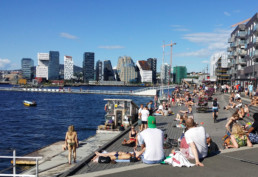Oslo strives to be a leading force in the green transformation, and will cut emissions in half by 2020 with its smart climate and energy strategy encompassing mobility, governance, and renewable energy.
The City of Oslo aims to cut greenhouse gas emissions 50% by 2020 and 95% by 2030 compared to 1990 levels. The strategy has three main areas: smart mobility, smart governance, and smart energy and comprises 16 initiatives such as reducing car traffic by 20%, phasing out the use of fossil fuel for heating and public transport, and eco-efficient procurement. All are intended to contribute to positive implications for climate change, urban planning and development, local transport, air quality, energy performance, eco‐innovation, and sustainable employment.
95% reduction in greenhouse gases by 2030
Cities100 – 2017
One of the most novel initiatives is integrating climate budgets as a part of the city’s financial budget and, as such, count carbon dioxide the same way the city counts money. It was launched in 2016, and is one of the first city carbon budgets in the world. All city departments have been given responsibility for goal attainment and annual expected progress on the targets in the climate budget. The quarterly and annual reports on the progress are managed within the existing formal financial and governance system of the city.

The challenge
Greenhouse gas emissions have increased by 25% since 1990 in Oslo. However, Oslo is in a unique position, with ready access to renewable energy and financial and human resources to develop and test new solutions, contributing to a better, greener, and more livable city.
Co-benefits
Economic New business opportunities have arisen in sectors like EV charging equipment and services, EV manufacturing, renewable fuels, e-bikes, green buildings, smart grid, and the circular economy.
Environmental The project will have a positive impact on reducing air and noise pollution, increasing biodiversity, and increasing the focus on reducing waste, waste recovery, and recycling.
Social As public transport increases its market share, Oslo will have more room for its residents, creating a more liveable city.
Health Reduced air pollution and more green spaces, as well as an increase in active transportation will improve citizens’ health.
About Oslo
Oslo is the capital and the most populous city in Norway. It constitutes both a county and a municipality. Oslo is the economic and governmental centre of Norway. The city is also a hub of Norwegian trade, banking, industry and shipping. It is an important centre for maritime industries and maritime trade in Europe. Oslo is considered a global city and ranked “Beta World City” in studies carried out by the Globalization and World Cities Study Group and Network in 2008. It was ranked number one in terms of quality of life among European large cities in the European Cities of the Future 2012 report by fDi magazine. A survey conducted by ECA International in 2011 placed Oslo as the second most expensive city in the world for living expenses after Tokyo.


